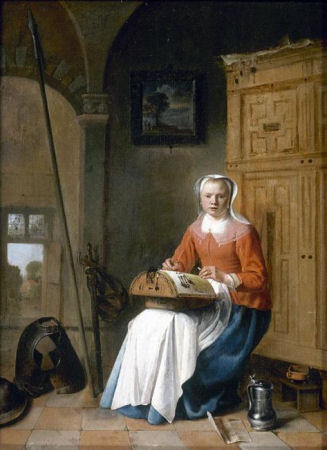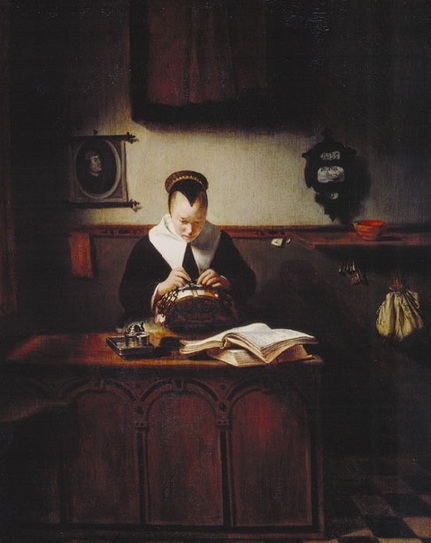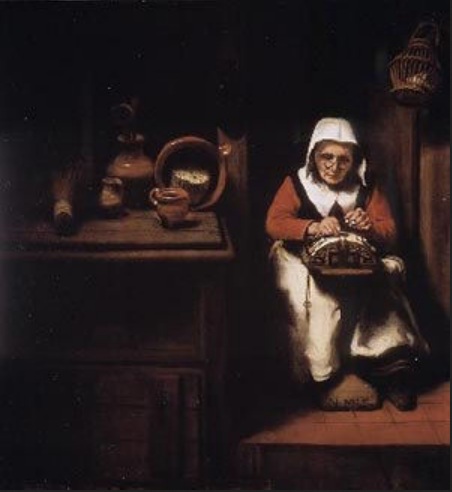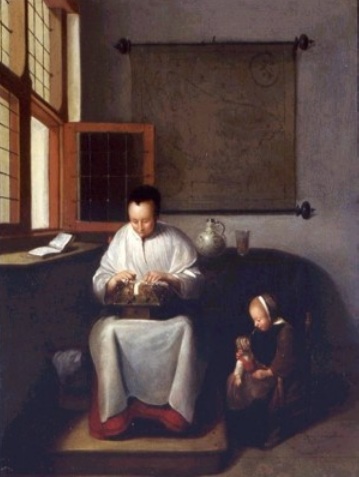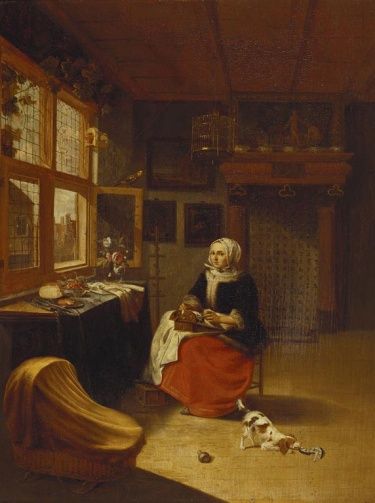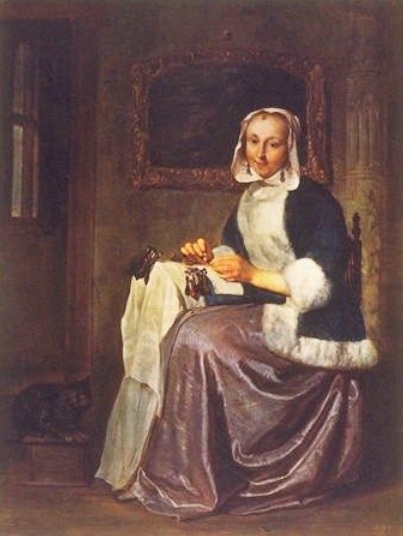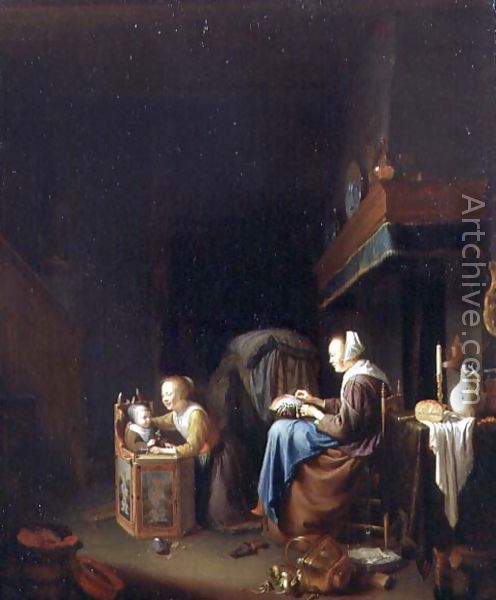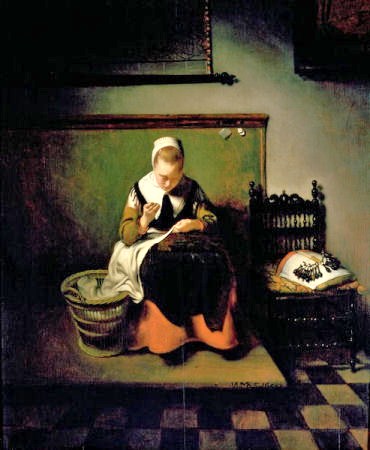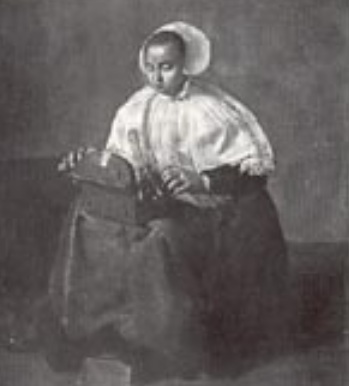Zarządzam chwilę odpoczynku od Sybil Carter. Gdy myślałam nad kolejnym postem, wydawało mi się, że koronki klockowe w malarstwie to taki krótki i nieskomplikowany temat. „O obrazie Vermeer’a „Koronczarka” oczywiście wszyscy słyszeli. Jest jeszcze kilka innych dzieł – w sam raz na jeden wpis na blogu”. Tak sobie myślałam. I jakże się myliłam!
I’m taking a little break from Sybil Carter. When I was thinking about writing a new post, it seemed to me that bobbin lace in painting would be a nice subject of a short and simple text. „Surely everyone has heard about Vermeer’s Lacemaker. There are several other paintings – enough to write one post about it”. That’s what I thought. And I couldn’t be more wrong!
Nicolaes Maes, Stara Kobieta Drzemiąc (tł wł) | Old Woman Dozing (1656)
Zamiłowanie malarzy do tematyki koronczarskiej sięga przełomu XVI i XVII wieku, rozwijało się przez kolejne stulecie i trwało niezmiennie aż do początku XX wieku. Bez problemu odnalazłam ponad sto obrazów przedstawiających pracę nad koronką klockową. Sądzę, że to i tak nie wszystko. Dlatego w pierwszym poście na ten temat postanowiłam opisać tylko holenderskie dzieła z XVII wieku.
Painters’ passion for this subject can be first observed at the turn of the 17th century. It developed throughout the whole century and even longer, until the beginning of the 20th century. I have found without any effort over one hundred paintings depicting lace makers at work. I guess it is still not everything there is to be found. That’s why I’ve decided to describe only Dutch works from the 17th century in my first post concerning bobbin lace in paintings.
 Caspar Netscher, Koronczarka | The Lace Maker (1662)
Caspar Netscher, Koronczarka | The Lace Maker (1662)
Właściwie chodzi nie tyle o zamiłowanie malarzy do koronek, co ich zainteresowanie tematyką życia codziennego. Wiek XVII to wiek malarstwa rodzajowego. W tym okresie koronczarstwo było szczególnie popularne na terenie dzisiejszego Beneluksu. Ogromne zapotrzebowanie na to rękodzieło w połączeniu z koniecznością znalezienia dodatkowych źródeł dochodów w wielu gospodarstwach sprawiło, że kobiety, ale również mężczyźni i dzieci zajęli się robieniem koronek w domowym zaciszu. Stąd powszechność tego motywu w holenderskim malarstwie z epoki.
Actually it is not as much about the painters’ passion for lace as about their interest in every-day life. 1600s is the age of genre paintings. Back then lace making was especially popular in todays Benelux countries. Huge demand for this handwork combined with the need to find additional source of income in many households resulted in women as well as men and children taking up lace making in their domesticity. That’s why the motif of lace making was so popular in Dutch paintings from the period (so called Dutch Golden Age).
Joost van Geel (1631 – 1698), Koronczarka | The Lace Maker
Z analizy zamieszczonej na tej stronie wynika, że holenderscy malarze mniej lub bardziej wiernie oddawali pracę koronczarki na swoich obrazach. Najbardziej wiarygodne dzieło to takie, które przedstawia koronczarkę (ewentualnie koronczarza) przy płaskiej podkładce na specjalnym stojaku lub z podkładką na kolanach.
Analysis published on this website shows that some Dutch painters were more and some of them were less thorough in reflecting the work of a lace maker in their paintings. The most credible piece of art would be the one displaying a lace maker with a pillow on a special stand or holding a pillow on her lap.
Pieter Jacobsz. Codde (1599-1678), Koronczarka | Lacemaker
Nicolaes Maes, The Lace Maker (1655)
Na obrazie powinna być widoczna odpowiednia ilość klocków (oby nie za mało, jak na obrazie Metsu poniżej), a robiona koronka nie może być podejrzanie wąska.
A sufficient number of bobbins should be visable in a picture (sometimes there are too few, like in this Metsu painting below) and the lace trim made by the worker shouldn’t be suspciously narrow.
 Gabriel Metsu, Koronczarka | The Lace Maker (c. 1660)
Gabriel Metsu, Koronczarka | The Lace Maker (c. 1660)
Nicolaes Maes, Koronczaraka |The Lace Maker (c. 1655)
Dobre oświetlenie to podstawa w pracy koronczarki, dlatego kobiety robiły koronki siedząc przy oknie lub na zewnątrz – pod domem. Koronki robiono raczej przy naturalnym świetle, a nie przy świeczce (jak na obrazie Gerrit Dou).
It is essential that the workstand of a lace maker is well lit. That’s why women often made lace by the window or outside. It was rather impossible for a lace maker to work by artificial light (as suggested by Gerrit Dou).
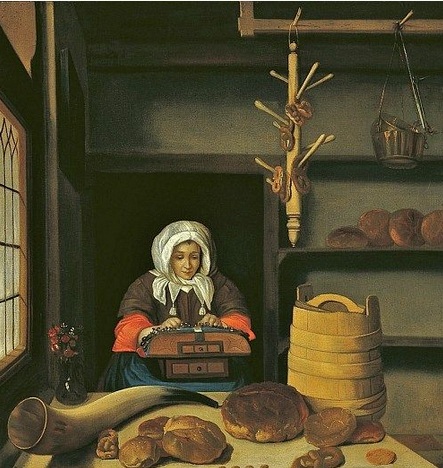 Job Adriaensz Berckheyde, Koronczarka | Lace Maker (1666-75)
Job Adriaensz Berckheyde, Koronczarka | Lace Maker (1666-75)
Quiringh Gerritsz. van Brekelenkam (c. 1622-1668),
A woman making lace with a small child beside | Kobieta robiąca koronki i dziecko (tł. wł.)
Pieter Cornelisz. van Slingelandt, Koronczarka | The Lace Maker (1670)
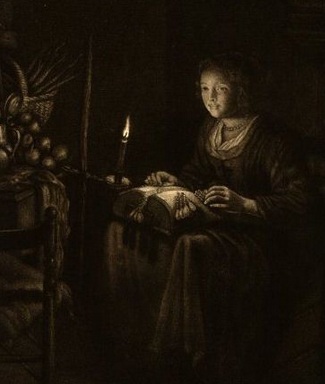 Gerrit Dou (1613-1675), Koronczarka | The Lace Maker
Gerrit Dou (1613-1675), Koronczarka | The Lace Maker
Dobra koronczarka powinna być skupiona na pracy, a nie zainteresowana tym, co dzieje się w około – najlepiej zatem wypadają obrazy, na których kobieta wpatruje się w swoją robótkę, trzyma w rękach klocki lub przepina szpilkę na poduszkę. Wiele obrazów prezentuje jednak rozkojarzone koronczarki.
A good lace maker is focused on her work, not interested in everything that is going on around her. So the best paintings are those in which the worker is looking at the lace she is making. She may be holding some bobbins in her hands or attaching pins to her pillow. However, many paintings display distracted lace makers.
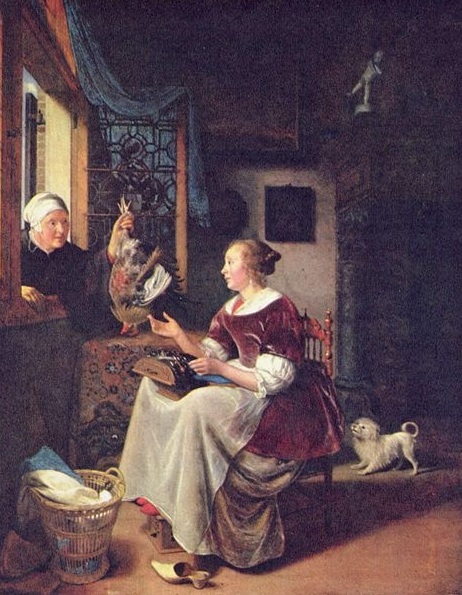 Pieter Cornelisz van Slingelandt (1672-1673), Młoda Koronczarka | A Young Lace Maker
Pieter Cornelisz van Slingelandt (1672-1673), Młoda Koronczarka | A Young Lace Maker
Jan Miense Molenaer (1610 – 1669), Koronczarka| Lace Maker
Gabriel Metsu (1629-1667) Koronczarka | Lace Maker
Dopuszczalne są również detale, jak na przykład przytwierdzony do podkładki sznurek, na którym zwisają nożyczki lub mała szufladka z tyłu podkładki.
Some details are also possible in portraits of lace makers, e.g. scissors hanging on a rope attached to the pillow or a small dawer at the back of the pillow.
 Nicolaes Maes (1632-1693), Koronczarka | The Lace Maker (c. 1650)
Nicolaes Maes (1632-1693), Koronczarka | The Lace Maker (c. 1650)
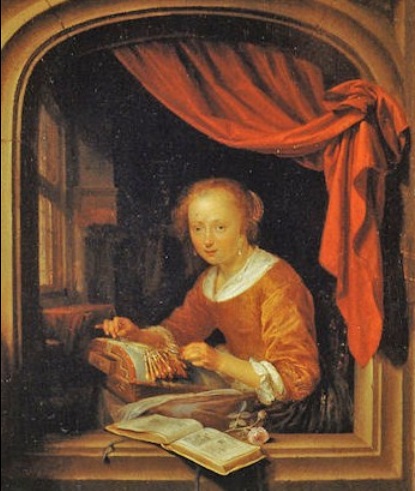 Gerrit Dou, Koronczarka | Lace Maker (1667)
Gerrit Dou, Koronczarka | Lace Maker (1667)
Powyższe wytyczne stanowią wyjaśnienie, dlaczego najsłynniejszy portret koronczarki to ten autorstwa Vermeera – najwierniej odzwierciedla widok koronczarki przy pracy. Narzędzia, stanowisko pracy, zachowanie i wyraz twarzy kobiety nie pozostawiają wątpliwości, że na obrazie widzimy prawdziwą koronczarkę przy pracy.
All of the characteristics of a good bobbin lace maker portrait explain why the painting by Vermeer is the most popular one. It reflects the lace maker at work most thoroughly. The accessories, the workstand, the behaviour and the look on the face of the woman on Vermeer’s painting make it clear that we can see a lace maker at work.
 Johannes Vermeer, Koronczarka | The Lace Maker (1669–1670)
Johannes Vermeer, Koronczarka | The Lace Maker (1669–1670)
Johannes Vermeer, Koronczarka – fragmenty | The Lace Maker – details (1669–1670)
Oto jeszcze kilka innych obrazów przedstawiających koronczarki:
Here are some more paintings of lace makers:
Pieter Cornelisz. van Slingelandt, Kobieta robiąca koronki i dwoje dzieci (tł.wł) | Woman Making Lace with Two Children (c.1670)
Nicolaes Maes, Koronczarka | Lace Maker (c. 1655)
Pieter Jacobsz. Codde (1599 – 1678), Koronczarka | A Lace Maker
Quiringh Gerritsz. van Brekelenkam, Wnętrze Zakładu Krawieckiego (tł. wł) | Interior of a Tailor’s Shop (1653)
Quiringh Gerritsz. van Brekelenkam, Wnętrze Zakładu Krawieckiego (tł. wł) – fragment |
Interior of a Tailor’s Shop – a detail (1653)
Temat koronkarstwa w holenderskim malarstwie XVII wieku nie został jeszcze wyczerpany. Myślę, że niektórzy artyści poświęcili tyle czasu na malowanie koronczarek, że zasługują na osobny post w przyszłości :).
That is not all there is to say about the lace making in the paintings of the Dutch Golden Age artists. I think some of the painters have devoted so much time to painting lace makers that they deserve their own post here – some time in the future :).


